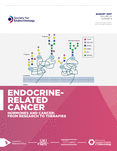Application of molecular biology of differentiated thyroid cancer for clinical prognostication
- 1IOS & COLEMAN Srl, Naples, Italy
- 2Department of Clinical Medicine and Surgery, Federico II University, Naples, Italy
- 3Thyroid and Parathyroid Surgery Unit, Istituto Nazionale per lo Studio e la Cura dei Tumori-IRCCS “Fondazione G. Pascale”, Naples, Italy
- Correspondence should be addressed to V Marotta; Email: vinc.endo{at}libero.it
-
Figure 4
Synergistic prognostic effect of co-occurrence of BRAF V600E and TERT promoter mutations in increasing the risk of tumour recurrence (ATYPESETTER: Please change “8,7%, 16,3%, 19,2%, 68,6%” to “8.7%, 16.3%, 19.2%, 68.6%” in the Figure 4. and B) and disease-related mortality (C and D) in DTC. Data from Xing et al. (2014b) (A), Xing et al. (2014a) (C), and Song et al. (2016) (B and D). †Not significantly different from the No mutations group; *Significantly different from the No mutations group; **Significantly different from the TERT promoter mutations only group; *** Significantly different from the BRAF V600E only group.
- © 2016 Society for Endocrinology












